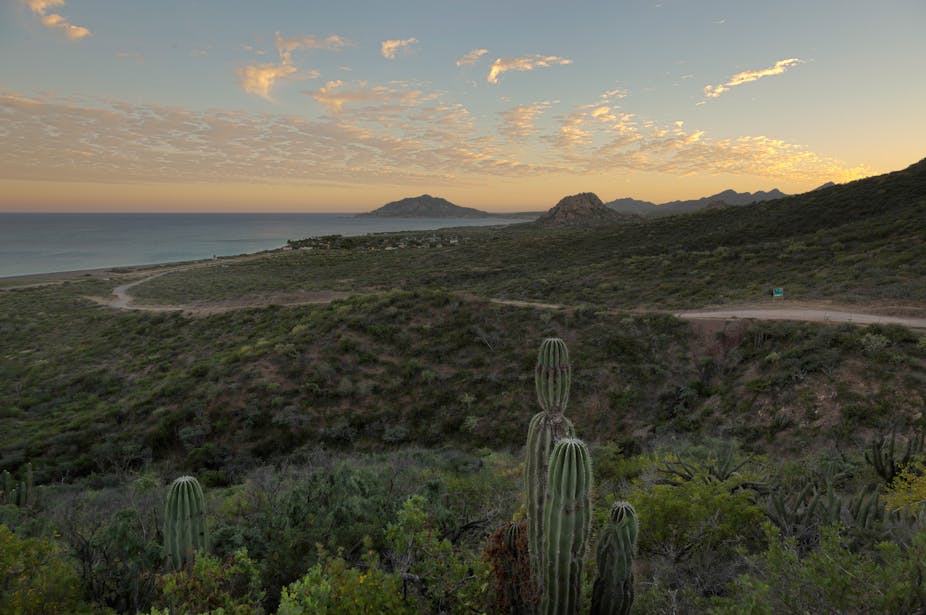When former Mexican president Felipe Calderon shut down the development of a planned US$2 billion, 4,000 hectare hotel mega-resort in 2012, it looked as though the extraordinary diversity of the Cabo Pulmo National Marine Park had escaped unscathed.
But barely a few years later new plans have arisen for the site in the country’s north east after ownership transferred from the now-bankrupt Spanish property company to a Chinese development firm, Glorious Earth Holdings. The planned 22,000-room hotel development on the Baja Californian coastline threatens not just the future of the coral reef, but also those species and habitats on land. Named “Cabo Dorado”, this is the third iteration for a mega-resort on the site.
The core of the proposed development is the picturesque beach dunes of Punta Arena, where the desert meets the sea. This is no ordinary sea: Cabo Pulmo National Park is perhaps the world’s most robust marine reserve and coral reef. Legendary underwater photographer and explorer Jacques Cousteau referred to the area as “the aquarium of the world”.
So while the significance of the coral reef is well recognised, the biological diversity of Punta Arena and around has remained unknown. Faced with potential destruction, our internationa team of scientists set about recording the plants and animals in the region, under the umbrella of a US-Mexican collaborative group dedicated to protecting the Sonoaran Desert and led by noted conservationist Exequiel Ezcurra, professor of ecology at the University of California, Riverside.

We were alarmed by what we discovered in the heart of the development zone that would be concreted. Published in a recent report, we found 560 types of plants and animals, but also two vegetation types found nowhere else on earth, and two newly described plant species known only from these 11 square kilometres. The sands of Punta Arena feature seasonally flooded lagoons and a thorn desertscrub that, due to the underlying geology, produce wholly unique soils. The plants, Bidens cabopulmoensis, a dune sunflower, and a large shrub, Pisonia calafia, are in serious danger of extinction if this project goes ahead. There are also many endemic species of reptiles, including active sea turtle nests on the beaches.
In contrast to our findings, the environmental impact statement (MIA, or Manifestación de Impacto Ambiental) undertaken on behalf of the developers stated there was nothing unique in the area. The MIA omitted 83% of the species found only in the region and nowhere else in the world, recorded 400 fewer plants and animals, and noted only 15 species protected by the Mexican government – compared to the 42 we found.
But these concerns are only part of the story. What will the impact of this mega-development be on the remarkable reef-system that is the heart of the region’s ecotourism and fishing industries? Where will the fresh water come from in the middle of this desert? The calculations for the water needed by the proposed development are a source of great concern for local businesses that depend on the aquifer.

We need to take a careful look at this kind of large development project. Far too many times along the coasts of Mexico we have witnessed the wholesale destruction of areas of great biological and cultural importance. On the headlands and mangrove estuaries of La Paz, Loreto, and other Baja California coastal cites, biologically important land has been razed for ambitious hotels and apartments, only for these buildings to be subsequently abandoned, to no one’s benefit and at great cost. By incorporating the extraordinary natural wealth of the region into development and building projects we can pursue a much more prosperous vision of the future for Baja California that matches the grandeur of landscape.
It’s clear the impact this mega-resort would have on local businesses, people and the landscape has not been adequately addressed. For example, the people of Cabo Pulmo – sustained almost entirely by ecotourism – face the imminent loss of the natural resources that provide them a living if the proposal is approved by the Mexican government.
In our final report, which we delivered to the environment department of the Mexican federal government, we recommend expanding the Cabo Pulmo National Park to include Punta Arena. The government is expected to make a decision by June 15. Hopefully this scheme can slayed a fourth time, and the area sufficiently protected to prevent it rising again in the future.

